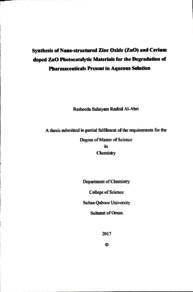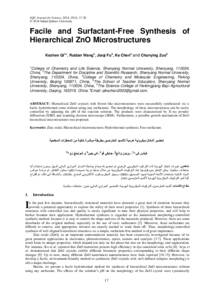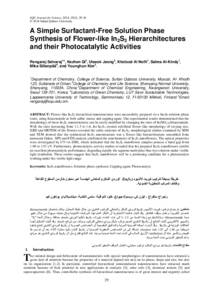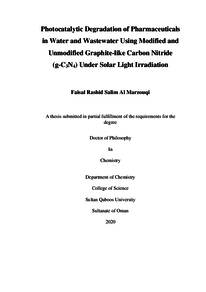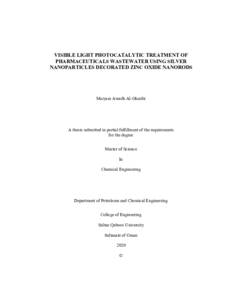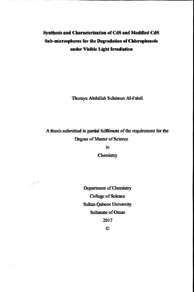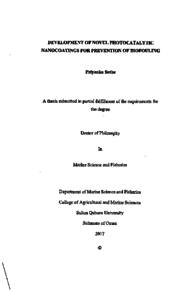Document
Synthesis of nano-structured zinc oxide (ZnO) and cerium doped ZnO photocatalytic materials for the degradation of pharmaceuticals present in aqueous solution /Rasheeda Sulaiyam Rashid AL-Abri
Publisher
Sultan Qaboos University
Gregorian
2017
Language
English
Subject
English abstract
Pharmaceuticals, newly recognized classes of environmental pollutants, are becoming increasingly problematic contaminants of either surface water or ground water around industrial and residential communities. Pharmaceuticals are constantly released into aquatic environments, mainly due to their widespread consumption and complicated removal in wastewater treatment plants. Heterogeneous photocatalysis appear to be one of the most destructive advanced oxidation processes (AOPs) for organic contaminants and it is possible to obtain complete mineralization of organic pollutants into ecofriendly end products under visible and solar light irradiation. In this work six types of zinc oxide and cerium doped zinc oxide photocatalysts with different particle size and morphology have been prepared by a simple hydrothermal method. The prepared samples were characterized by various analytical techniques such as XRD, Raman, XPS, UV-DRS, FT-IR, SEM and EDX. XRD studies revealed that the prepared ZnO samples are wurtzite hexagonal structure. Morphological studies examined by SEM showed that the synthesised ZnO and Ce doped ZnO shows chrysanthemum like structure and were constructed by several nanorods and nanosheets. The grain size of ZnO and Ce doped ZnO particles were calculated by using Debye-Scherrer formula and varied from 31 nm to 77 nm. XPS and EDX analysis confirmed the stoichiometry of pure ZnO and Ce doped ZnO nanostructures. The optical properties were investigated by UV-vis DRS, which indicated that the ZnO and Ce-ZnO possess a band gap from 3.20 eV to 3.15 eV. The Ce doping into ZnO slightly altered the band gap from 3.20 eV to 3.15 eV. Furthermore, the photocatalytic activity studies revealed that the as-prepared ZnO and Ce-doped nanostructured materials exhibit an excellent photocatalytic performance for degradation of pharmaceutical solution, such as nizatidine, levofloxacin and acetaminophen under UV-B light irradiation. The photocatalytic mineralization of pharmaceuticals has been enhanced over the as-prepared Ce-doped ZnO when compared to pure Zno. Around 95% of the degradation of these pharmaceuticals was achieved within 4 hrs. These results suggest that ZnO and Ce-doped ZnO will be the promising candidate for the decontamination of hazardous low concentrated pollutions in water.
Description
Thesis
Member of
Resource URL
Arabic abstract
تعتبر المستحضرات الصيدلانية التي تم الاعتراف بها حديثا ملوثات بينية للمياه سواء السطحية أو الجوفية حول المجتمعات الصناعية والسكنية، حيث يتم إطلاق الأدوية باستمرار في البينات المائية، ويرجع ذلك أساسا إلى استهلاكها على نطاق واسع وصعوبة إزالتها في محطات معالجة مياه الصرف الصحي، ويبدو أن التحفيز الضوئي غير المتجانس هو واحد من أكثر عمليات الأكسدة المتقدمة تكسيرا للملوثات العضوية ويمكن الحصول على تمعدن كامل للملوثات العضوية في منتجات نهائية صديقة للبيئة تحت الأشعة الضوئية المرئية وضوء الشمس، وفي هذه الدراسة تم تحضير ستة أنواع من أكسيد الزنك (ZnO) وأكسيد الزنك المعدل بالسيريوم (Ce - doped ZnO) متباينة ف الأحجام و الأشكال بواسطة الطريقة الحرارية المائية البسيطة تعمل كمحفزات ضوئية، وتم تحليل العينات المحضرة بتقنيات تحليلية مختلفة مثل تقنيات حيود الأشعة السينية( XRD وEDX)، الطيفي (Raman)، الأشعة السينية الضوئية الطيفية (XPS)، الأشعة فوق البنفسجية منتشر الانعكاس الطيفي ( UV - DRS ) ومجهر المسح الإلكتروني (SEM) من أجل التأكد من تركيبها الكيميائي ودراسة خصائصها البصرية وكشفت نتائج التحليل أن المواد التي تم تحضيرها تتراوح أحجامها ما بين 31 إلى 77 نانومتر، علاوة على ذلك كشفت دراسات النشاط التحفيزي الضوئي أن المواد النانومترية التي تم تحضيرها على شكل أكسيد الزنك وأكسيد الزنك المعدل بالسيريوم تظهر أداء ممتاز للتحفيز الضوئي لتكسير المركبات الدوائية مثلlevofloxacin ) ، ( nizatidine) و (acetaminophen) تحت أشعة الضوء فوق البنفسجية، وقد تم تعزيز التمعدن الضوئي لهذه المركبات بواسطة المحفز أكسيد الزنك المعدل بالسيريوم بالمقارنة مع أكسيد الزنك النقي حيث تم تحقيق حوالي 95% من تكسير هذه المستحضرات الصيدلانية في غضون 4 ساعات، وتشير هذه النتائج إلى أن أكسيد الزنك وأكسيد الزنك المعدل بالسيريوم هي مواد فعالة لإزالة الملوثات من المياه الملوثة حتى وإن كانت نسبة وجودها ضئيلة
Category
Theses and Dissertations

